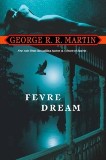Though Anne Rice is perhaps the best known writer of vampires, around about the same time that Interview with the Vampire was published another notable author had written a piece of vampire fiction. It didn’t get as much press at the time, but his name is now synonymous with epic fantasy: George R. R. Martin. Often called “the American Tolkien” for his epic A Song of Ice and Fire fantasy series, Martin wrote several novels in a wide variety of genres before settling in to write his masterpiece.
One of those novels was Fevre Dream, a novel of vampires on the Mississippi River. In Fevre Dream a down-on-his-luck steamboat operator and captain is given an offer by a strange man named Joshua York. York keeps strange hours, has ghostly pale skin, and drinks a rather strange-tasting liquor. But Captain Abner Marsh is in no position to argue when York offers to pay for the building of a steamboat the likes of which the Mississippi has never seen. Even when York requires strange terms and conditions. Abner’s decision to live with those conditions in order to rebuild his fortunes will change his life forever.
Martin’s contribution to paranormal fantasy is like-but-unlike Rice’s. Although both take place primarily in a historical context in the same region of the United States, it is there the similarity ends. Rice’s vampires are more traditional, having all the attributes that tend to make them popular with readers of books like Stephenie Meyer’s Twilight. Martin’s vampires are more scientific, and although they are like humans, they are not simply a personification of human attributes readers wish they had, but something different, something alien. This novel is more science fiction than fantasy, and as a result reads much more like Asimov or Heinlein than Tolkien or Rice.
In a sense, this is paranormal fantasy for people who prefer science fiction. It is much more factual, and if the reader were to take away the vampire/steamboat aspect of the narrative, then this novel could just as easily have taken place on an alien world or between the stars. This lack of need to rely on setting can be seen in two different ways. Readers could say that this means the narrative is indistinct, lacking anything unique, anything to make it better than its contemporaries. Or you can see it as I do, which is its universality. Its themes and characters are what make this novel interesting, not only its setting. They speak to the reader across the specifics of time and place and reach into the mind and the conscience.
Abner Marsh, as the human protagonist, is particularly interesting. It is he, not the vampire York, on whom readers should focus. Since the story is told from his point of view, this is easy to do, but readers who read vampire novels for vampires might miss the thrust of the novel. That thrust is in the unpredictability, loyalty, honor and courage of the human race. It is humans, not vampires, who are the heroes, and it is their adaptability and forward progress that is leading to the slow decline of the vampire race.
This is juxtaposed against humanity’s own backwardness in its attitude toward slavery. In essence, the story of the conflict between vampires and humans provides a metaphor for the very attitudes and behaviors of white men during the African slave trade. Though the conclusions are obvious to any student of history, Martin’s use of a rhetoric that generally refers to a “superior” race to address attitudes still common enough in America is creative and different.
The novel also entertains with exciting stories of life on the river. Some of the very things that make Mark Twain’s Adventures of Huckleberry Finn so great are resident in this narrative as well. There are steamboat races, night time chases, and hand-to-hand combat to be found here as well. So even as deep thinking is engendered in your mind, the reader is also thoroughly entertained by mystery and adventure.
Fevre Dream is a thoroughly entertaining novel. It is unlike many of its kin in the paranormal subgenre. And readers will see the faint stirrings of the master author that Martin would become in its pages. It is a must read for any fan of George R. R. Martin, vampire novels, or those who like to see tropes twisted into different shapes. Its theme is a challenge and a poke to the conscience, and yet it still is a highly entertaining story.
John Ottinger III writes for various science fiction and fantasy publications. He also blogs about the genre at Grasping for the Wind.










